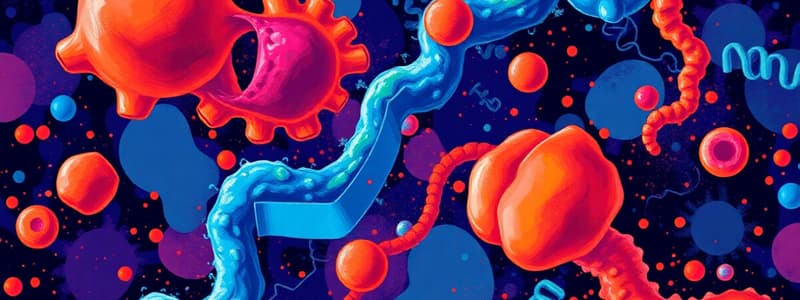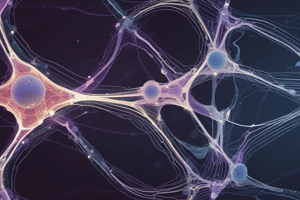Podcast
Questions and Answers
Which of the following is NOT a defining characteristic of life?
Which of the following is NOT a defining characteristic of life?
- Presence of a nucleus (correct)
- Metabolic activity for growth and reproduction
- Presence of a membrane-bound boundary
- Ability to evolve through natural selection
What is the primary function of nucleic acids in cells?
What is the primary function of nucleic acids in cells?
- Storing and transmitting genetic information (correct)
- Facilitating cell communication
- Serving as primary energy sources
- Providing structural support
Which of the following statements correctly describes the genetic code?
Which of the following statements correctly describes the genetic code?
- There are 64 possible codons, each encoding a specific amino acid.
- Codons are always read in the 3' to 5' direction on mRNA.
- Each amino acid is encoded by a single specific codon. (correct)
- The order of amino acids in a protein determines the sequence of nucleotides in a gene.
What is the role of tRNA in protein synthesis?
What is the role of tRNA in protein synthesis?
Which of the following is a key function of lipids in cells?
Which of the following is a key function of lipids in cells?
What is the main difference between prokaryotic and eukaryotic cells?
What is the main difference between prokaryotic and eukaryotic cells?
Which of the following statements correctly describes the role of proteins in cells?
Which of the following statements correctly describes the role of proteins in cells?
Which of the following is a key difference between DNA and RNA?
Which of the following is a key difference between DNA and RNA?
What is the main reason why eukaryotic cells have compartmentalisation?
What is the main reason why eukaryotic cells have compartmentalisation?
What is the primary role of introns in eukaryotic gene structure?
What is the primary role of introns in eukaryotic gene structure?
How does the endosymbiotic theory explain the origin of eukaryotic cells?
How does the endosymbiotic theory explain the origin of eukaryotic cells?
What is the approximate size difference between a prokaryotic cell and a eukaryotic cell?
What is the approximate size difference between a prokaryotic cell and a eukaryotic cell?
What is the primary role of the regulatory regions in a eukaryotic gene?
What is the primary role of the regulatory regions in a eukaryotic gene?
Which of the following is NOT a feature of prokaryotic cells?
Which of the following is NOT a feature of prokaryotic cells?
What is the primary type of RNA involved in protein synthesis?
What is the primary type of RNA involved in protein synthesis?
What is the significance of the Asgard archaea in the understanding of eukaryotic evolution?
What is the significance of the Asgard archaea in the understanding of eukaryotic evolution?
Flashcards
Cell Membrane
Cell Membrane
A lipid barrier surrounding all cells, regulating what enters and exits.
Eukaryotic Cells
Eukaryotic Cells
Cells with a nucleus and organelles, larger than prokaryotes.
DNA Function
DNA Function
Contains genetic information; transcribed into RNA for protein production.
RNA Types
RNA Types
Signup and view all the flashcards
Introns and Exons
Introns and Exons
Signup and view all the flashcards
Endosymbiotic Theory
Endosymbiotic Theory
Signup and view all the flashcards
Origins of Life
Origins of Life
Signup and view all the flashcards
Gene Regulation
Gene Regulation
Signup and view all the flashcards
Cells
Cells
Signup and view all the flashcards
Universal Genetic Code
Universal Genetic Code
Signup and view all the flashcards
Nucleic Acids
Nucleic Acids
Signup and view all the flashcards
Codon
Codon
Signup and view all the flashcards
Proteins
Proteins
Signup and view all the flashcards
Lipids
Lipids
Signup and view all the flashcards
Sugars
Sugars
Signup and view all the flashcards
Prokaryotes vs Eukaryotes
Prokaryotes vs Eukaryotes
Signup and view all the flashcards
Study Notes
Building Blocks of Life
- Life is composed of fundamental molecular building blocks: nucleic acids, proteins, lipids, and sugars.
- Nucleic acids (DNA and RNA) encode information in cells.
- Proteins carry out most cellular functions, speeding up reactions, transporting molecules, providing support, and repairing damage.
- Lipids form cell membranes, acting as barriers and playing a role in energy storage and communication.
- Sugars are major energy sources and structural components.
- There are 68 molecules contributing to these four major groups.
Cells
- Cells are the fundamental units of life.
- Prokaryotic cells (bacteria and archaea) are simpler than eukaryotic cells (larger, more complex).
- All cells: sense and respond to their environment, contain DNA, are surrounded by a membrane, and share common building blocks.
- Virus' are smaller than prokaryotes and need a host cell to replicate.
- Eukaryotic cells overcome limitations of size with compartmentalization and specialization capabilities.
- Organelles in eukaryotic cells carry out specific functions.
Gene Structure and Function
- Genes are DNA sequences transcribed into RNA.
- RNA types include mRNA (translated into protein), tRNA and rRNA (protein synthesis), and miRNA (gene expression regulation).
- Non-coding DNA regions include introns, regulatory sequences, and other elements.
- Genes have directions, coding and regulatory regions, and control transcription factor and RNA polymerase activity.
- RNA polymerase transcribes genes and the introns are spliced out.
Origins of Life (Cells)
- The Last Universal Common Ancestor (LUCA) existed approximately 4.3 billion years ago.
- Eukaryotic cells evolved from prokaryotic ancestors through endosymbiosis, a process where one cell engulfed another, leading to the creation of organelles like mitochondria and chloroplasts.
- Mitochondria and chloroplasts originated as free-living organisms.
- Asgard archaea are closely related to the last common ancestor of eukaryotes.
Studying That Suits You
Use AI to generate personalized quizzes and flashcards to suit your learning preferences.




